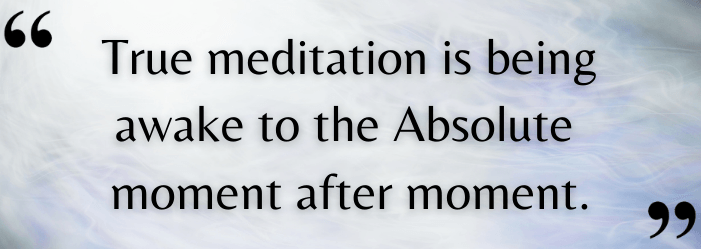Episode 8: A review of "Neti-Neti Meditation" by Andre Halaw (Part 2)
Podcast Episode #8: A review of Andre Halaw's book Neti-Neti Meditation chapters 4–7
Click here to see the video version on YouTube or scroll down to see the video embedded on this page.

In the previous episode, we talked about the first half of Andre Halaw’s book “Neti-Neti Meditation.” In this episode, we'll cover the last half of the book, starting with Chapter Four, “Neti-Neti on the Cushion”. In this chapter, Halaw describes the process of Neti-Neti meditation in detail.
First of all, no formal position is necessary for this meditation. I’ve heard this from more than one person regarding meditation in general. Just get comfortable in an upright position in a chair or on a cushion, relax, close your eyes, and slow your breathing.
Then you'll concentrate on your body. Ask yourself, “What is this body? Where does it begin and where does it end?” Examine any discomfort you are feeling, including any labels or stories associated with it. Then let go of these things.
Next you'll investigate the question of “Where do I find the ‘I’ of my body?” Work up from your toes, through your organs, to your head. Is your ‘I’ located in any of those places? No, they are all Neti-Neti; our beingness transcends all of our body parts and the “I” is a myth.
The process is the same as we examine the question of “Am I my whole body?” Although it makes sense that none of our individual body parts is “me”, we still tend to identify ourselves with our complete bodies. But if our “selves” were found only in our whole body, what would happen if we lost a limb? Would I no longer be “me” if I lost a part of my body? The answer is no, so the “I” cannot be found in the complete body.
Next, go through your senses to see if you can find the “I” there. “Am I my eyes? Am I what I see? Am I my tongue or what I taste? If I lose my sight or sense of smell, am I still ‘me’?” With thorough investigation, we find that our senses are not “me”.
The idea that you are not your senses can be difficult to overcome. We tend to identify very strongly with what we see, as well as what we smell, taste, hear, and touch. It’s important to include these ideas in your daily meditation to help you negate them.
Halaw points out that these meditations can be especially useful for someone experiencing chronic pain. It helps to realize that pain is neither good nor bad, just a labeled idea. Through Neti-Neti you will find that your pain does not define you. The pain just “is”—it is not “yours” and you are not the pain.
During meditation, after analyzing your physical self, look at your emotions. Ask yourself, “Am I anger, fear, anxiety, joy, love,
sadness, any other emotion?” Bring them to the forefront and experience them fully. Examine whether they are “I”, “me”, or “mine”. The answer will always be no. Your true nature transcends all labels. As Halaw puts it, “Sensations arise from Nothingness, last for a bit, then subside into Nothingness.” To define yourself with a label such as “anxious”, “depressed”, or even "joyous" gives these base objects more permanence than they deserve. These labels obscure the Thusness that is your true nature.
The next step of the Neti-Neti meditation process is to identify your most common social and family roles and realize that you are not them. You may be a father, mother, employee, teacher, Buddhist, Christian, etc. Bring each role to mind along with the emotions engendered by any relationships and associations you have with others through each role. Experience each fully, and then realize that you are not these roles; each is a fleeting idea that does not represent your true nature.
In the next stage of the meditation, you will examine your thoughts. Actively think, and when you hear your internal voice, ask yourself, “Am I my thoughts?” This cannot be true. If you were your thoughts, then you would cease to exist when you sleep and don’t think. By investigating the question “Where do these thoughts come from?” you’ll find they come from nowhere, out of the Nothingness of the Void, manifestations of the Absolute. Thoughts are just ideas and have no form in the real world. Nouns such as “paper”, “person”, and “mouse” are just words we use to make sense of the Absolute made manifest.
According to Halaw, “Reality precedes and transcends concepts.” This is key to seeing past manifest reality and experiencing the Absolute in our everyday lives. In trying to locate the origin of our own thoughts, we find emptiness, our true nature.
Our next meditative exploration will be the story we tell about ourselves. Though we have many stories that we tell others to explain who we are, Halaw encourages us to find one central story to focus on during this meditation. His examples include, “I am the victim, the loner, the rebel, the smart person, the dumb child, etc.” He stresses that these are just stories, nothing more. They no more define our true nature than a fictional novel would. Any story that you have about yourself is inherently untrue, a narrative about a character that does not exist. Nobody was ever “the cool kid,” “the dork,” “the star football player,” or “the shy kid in class.” The “I” in these stories never existed, and these are just labels on linear events that do not define anyone.
The final stage in the process is to try to find the “I Am-ness” of your self. When you try, you may find yourself shying away from looking into your own emptiness. “I Am” relates to your own beingness, and you may be tempted to see your own will as your “self”, but your “self” precedes your will. You will find that anything you can perceive is not you. As Halaw says, “The eye cannot see itself; the ear cannot hear itself; and the mind cannot know itself.” After searching for your “self”, you will be left with a “vague impression of existence, void of a substantial ‘I’.” You are not “I Am”, only Neti-Neti.
In the next chapter, Halaw summarizes everything that we have learned so far and takes us directly through the whole Neti-Neti process. In the end, we can declare that we are “none of these” things—not my body, emotions, roles, thoughts, personal story, or the feeling of “I am.” When it comes time to ask, “What am I?”, there is no answer. As Halaw says, “Anything that comes and goes is NOT you.” He asks you to contemplate what existed before you were born, and what will exist after you and your thoughts disappear. What is there before nonduality, Thusness, and the manifest realm? Words cannot express it. The closest we can come is to call it the unmanifest Absolute.
In the final chapters, Halaw explains that this is not the end, but the beginning. He emphasizes that experiencing this awakening now is but a moment in your journey. As you go out into the world, take this knowledge with you. He says, “True meditation is being awake to the Absolute moment after moment.” Emotional states of being are transient, so don’t try to hold onto them. Instead, carry with you the “understanding that the entire world of form is a manifestation of the Absolute.” With this realization, you are now free to embrace the world and the things you have negated, for they are all expressions of It-with-a-capital-I.
Neti-Neti is a never-ending process. We are still human after all, and we are easily seduced into thinking that there is more for the “I” to know. If we think we are enlightened, then we are not, because the “I” is incompatible with the Absolute. But don’t be discouraged. As Halaw puts it, “The ‘I’ is just a provisional label that we assign to the flow of experience interpreted by our nervous system. It serves a social function, but should not be taken too seriously.”
After investigating what we are not and discovering the Absolute, we will go about our lives, interacting with the world of the manifest realm. But our lives will be richer for having examined our true nature, and finding that we are all part of what Halaw calls “the great Not-That.”

